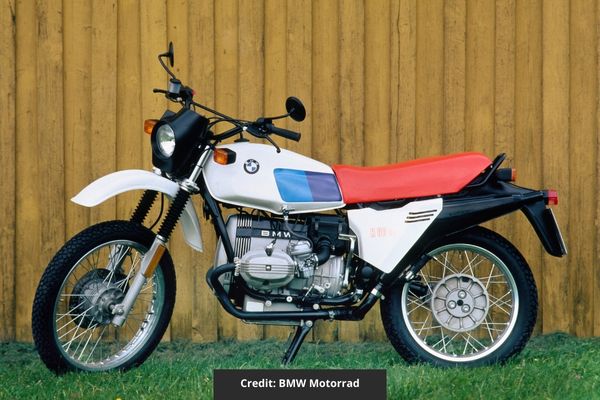BMW Motorrad: 100 years on two wheels
Like many great moments in history, necessity spurred BMW on to build its first motorcycle and create a dynasty that is now celebrating its centenary.
Prior to the launch of BMW’s first motorcycle in 1923, though, the firm had already been a major builder of engines, first for aircraft and then for farm equipment and also for other motorcycle manufacturers. When BMW merged with the Bayerische Flugzeugwerke motorcycle company in 1922, it was the perfect chance for BMW’s Chief Designer Max Friz to realise his long-held passion to build his own motorcycle. Holed up at home, Friz came up with the whole bike in just four weeks and the resulting R32 was launched at the German Motor Show in September 1923. It gave BMW the boost it needed in sales and finances to become the company it is today.
BMW R32

Amazingly, the R32 bears more than a passing resemblance to the bikes BMW is noted for today as the 1923 machine uses a flat-twin motor and shaft drive to send power to the rear wheel. With its background in aero engines, BMW made sure the new 494cc 8.5hp motor was reliable and oil tight, which is not something that could be said of most of its rivals at the time. It was also decently quick for the period with a top speed of 58mph.
That encouraged BMW to add a sportier model in 1925 with the R37. It used the same engine capacity, but power was upped to 16hp, allowing for 70mph flat out. Sales of the R37 were slow, so BMW sought to increase sales with a simpler, cheaper model called the R39. It was powered by a single-cylinder 247cc motor and started another BMW tradition of using this engine configuration for its more affordable models that persists to the present with the G310R.

As BMW moved into the 1930s, racing and record-breaking became an obvious way to promote the company’s bikes. In 1937, using a supercharged 500cc bike, Ernest Henne set an outright motorcycle top speed record of 173.7mph that lasted for 14 years. This was helped in part by the interruption of the Second World War, which saw BMW’s reliable machines used by the German military. The R75 of 1941 proved itself a strong machine when allied to a sidecar and it was built with high and low ratios so it was very capable on- and off-road. By 1944, more than 18,000 R75s had been made, consolidating how BMW would approach making bikes for decades to come.
After the war, BMW’s factory in Russian-controlled Eisenach continued to make bikes with the BMW name, but this was changed to EMW when the West German-based headquarters won a legal battle with the East German government. With permission to restart motorcycle production in 1947, BMW launched a warmed-over version of its pre-war single-cylinder bike and called it the R24. While not the most exciting machine, it got the company rolling again and is now regarded as one of the most important bikes in the firm’s history.
BMW R24

The first post-war flat-twin was the R51/2, but as cars became more affordable BMW found its motorcycle sales were dwindling by the late 1950s. Something needed to be done and the German firm’s decision was to push upmarket with bikes of superlative quality and build. It was the right decision and led to the /5 range that arrived in 1969. These bikes formed the basis of all ‘boxer-engined’ BMWs to follow for the next 25 years, including the R90 S and seminal R100 RS with its full fairing.
In 800cc form, this engine was a key component in the 1980 R80 G/S, which means Gelände/Straße or off-road/road in English. This was exactly what the bike was intended for, to be used as an all-rounder whether you wanted to commute or take part in the Paris-Dakar Rally. Rightly so, this first G/S is now a classic in its own right as the bike that informed how modern BMWs would look and feel.
BMW R80GS

As BMW moved into the 1980s, it diversified from its boxer engines to add the K100 with its inline four-cylinder motor. This was laid on its side to lower the bike’s centre of gravity and gave it an individual look. It joined the three-cylinder K75 in 1985, and both gained a similar reputation for durability to the boxer-powered bikes. The peak of the K range arrived in 1988 with the K1, which was way ahead of its time thanks to an all-enveloping fairing and wind tunnel aerodynamics when most other superbikes just relied on throwing more power at the engine to increase performance.
Using the K1’s design influence, BMW updated its Boxer range in 1993 with a move to oil-cooled flat-twin engines with the R1100. By now, telelever front suspension was the norm on BMW bikes, which minimised fork dive under heavy braking. This suspension wasn’t used on the first GS model of 1980, but the R850 and R1150 GS bikes of 1998 did and they started the whole adventure bike craze that’s still with us today. However, just like the original G/S, and note the slash in the first model’s name, they all used shaft drive that meant riding off-road didn’t incur hours of cleaning a chain afterwards.
Massively competent, and just as massive to stand next to, these GS models were a crucial turning point for BMW Motorrad, as the company’s two-wheeled division is known. It banished the worthy but dull perception of the firm’s bikes and made them desirable in a way only Ducati or Harley-Davidson could match at the time. Without this, BMW would likely not have gone on to create bikes like the hugely fast S1000RR superbike, its latest scooter range, or the amazing M1000R.
In your opinion, which two-wheeled machine represents the pinnacle of BMW Motorrad? Let us know what you think below.
actually their first engine was 1921 and put into a motorcycle then the Victoria, but it is true that it was 1923 when they made their own motorcycle from scratch I've see a lot of their machines over the years while building my website. Here's the galley of the best BMWs that I have seen: http://dogdragons.com/dogdragons/a-2-z/b/bmw/bmw-motorcycles.html
Dogdragon, 26/08/2023

The R1200c is a machine that has to be ridden and with experience of other bikes the way it makes you feel. A ride on a 1200C needs an NHS prescription for the clinical treatment of depression.
Chromer, 26/08/2023
COMMENT